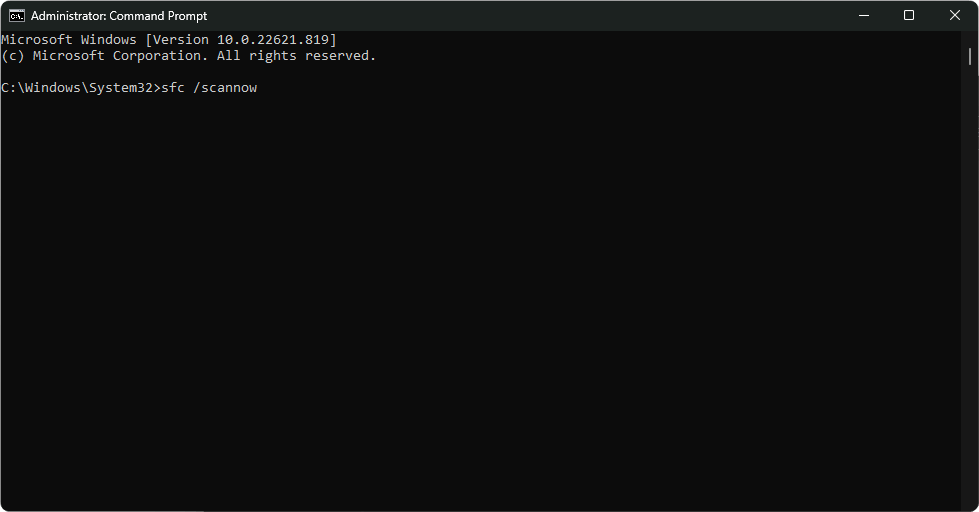В параметрах графики Windows 11 и Windows 10 (начиная с обновления в мае 2020) присутствует функция «Планирование графического процессора с аппаратным ускорением», призванная снизить задержки в играх и других графически интенсивных приложениях.
В этом материале о том, что делает функция планирования GPU, включать ли её и как включить планирование графического процессора с аппаратным ускорением.
Что делает функция и стоит ли включать её
Планирование графического процессора с аппаратным ускорением призвано снять часть нагрузки с центрального процессора, что, в некоторых случаях, может улучшить общую производительность в играх, а главное — снизить инпут-лаг (задержку при вводе).
Стандартно (без использования функции) планирование команд и их отправка для GPU (видеокарты) выполняется процессором с помощью планировщика WDDM, при этом команды отправляются не по одной, а пакетами (буферизация кадров). Это позволяет улучшить частоту кадров, но может приводить к задержкам ввода в играх: то есть отклик на действие пользователя происходит при отправке следующего пакета.
Планирование графического процессора с аппаратным ускорением снимает часть выполняемых процессором задач и передает их на обработку планировщику видеокарты. В случае, если узкое место вашего компьютера — это процессор, либо какие-то из игр нагружают его на 100%, включение рассматриваемой функции может быть полезным: но для каждого конкретного случая изменения будут заметными. Это лучше проверить самостоятельно, результат может отличаться в зависимости от игры и конкретной системы: например, тесты показывают, что результат тем лучше, чем мощнее используемая видеокарта.
Эффект от включения функции может проявиться не только в снижении инпут-лага и производительности в играх: в некоторых случаях этого можно и не наблюдать, но получить снижение нагрузки на процессор и его температуры в играх.
Как включить планирование графического процессора с аппаратным ускорением в Windows 11 и Windows 10
Для того, чтобы функция была доступна для включения, должны выполняться следующие условия:
- Установлена Windows 11 или Windows 10 с обновлением компонентов от мая 2020 года.
- Компьютер оборудован видеокартой NVIDIA GeForce 10-й или более новой серии, AMD Radeon RX 5600 или более новой.
- Установлены драйверы видеокарты, желательно — новые.
Параметры
Для того, чтобы включить планирование графического процессора с аппаратным ускорением в Параметрах, достаточно выполнить следующие шаги:
- Нажмите правой кнопкой мыши по рабочему столу и выберите пункт «Параметры экрана».
- В Windows 11 нажмите «Графика» в разделе «Сопутствующие параметры», а в Windows 10 — «Настройки графики» ниже раздела «Несколько дисплеев».
- В Windows 11 дополнительно перейдите в раздел «Изменение стандартных параметров».
- Включите опцию «Планирование графического процессора с аппаратным ускорением».
Если переключатель для включения функции отсутствует, это может говорить о том, что на компьютере отсутствует подходящее оборудование с её поддержкой, либо не установлены актуальные драйверы дискретной видеокарты NVIDIA или AMD.
Редактор реестра
Ещё одна возможность включить функцию — реестр Windows:
- Нажмите клавиши Win+R на клавиатуре, введите regedit и нажмите Enter.
- В открывшемся редакторе реестра перейдите к разделу
HKEY_LOCAL_MACHINE\SYSTEM\CurrentControlSet\Control\GraphicsDrivers
- Нажмите правой кнопкой мыши в правой панели редактора реестра и создайте новый параметр DWORD (32-бит) с именем HwSchMode
- Дважды нажмите по параметру и задайте значение 2 для него, сохраните изменения.
- Закройте редактор реестра и перезагрузите компьютер.
Подводя итог: если вы не знаете, стоит ли включать планирование GPU с аппаратным ускорением в Windows, лучший способ определить это — попробовать включить и посмотреть, как изменится отзывчивость игры на ввод, а также нагрузка на процессор и его температура. Если окажется, что выгоды от включения заметны, стоит оставить функцию включенной. Кроме этого, следует учитывать, что в разных играх результат может отличаться.
Readers help support Windows Report. We may get a commission if you buy through our links.
Read our disclosure page to find out how can you help Windows Report sustain the editorial team. Read more
Is hardware-accelerated GPU scheduling not showing on your Windows PC? Usually, you should find this option on Display Settings on Windows 11 and 10.
It is not a big concern whether you should turn on GPU scheduling or not. But, it is critical if you don’t find the option. For some users, this feature may go missing for unknown reasons, even with a decent graphics card. The good thing is you can quickly solve this problem.
Why is hardware-accelerated GPU scheduling missing on my PC?
If you don’t find this option on your computer, it might be due to the following reasons:
- Outdated GPU driver: If your graphics driver is extremely outdated, many modern Windows features may stop working.
- Incompatible GPU: Not all graphics cards work with GPU scheduling. For example, most AMD graphics cards got GPU scheduling support not very long ago.
- Outdated Windows: If you are using a very old version of Windows, some features may go missing or may not work at all.
- Problematic system files: Corrupted system files also can be a reason you do not see the option in settings.
How do I fix hardware accelerated GPU scheduling not showing?
Before trying the main methods, you should check the following things:
- Make sure you use one of the graphics cards compatible with your current operating system’s WDDM version. For example, Windows 11 requires WDDM 3 or later versions.
- Update Windows to the latest version.
After ensuring the above things, follow these methods to solve the hardware-accelerated GPU scheduling missing issue.
1. Update graphics card driver
- Open the Start Menu, type Device Manager, and press Enter to open Windows Device Manager.
- Expand Display adapters.
- Right-click on the Display Driver and choose Update.
- Choose the preferred method to update.
- After updating, restart your computer.
Now, go back to the Windows Display Settings and see if the hardware-accelerated GPU scheduling is showing or not.
Please note that the device manager may not find the latest driver for your GPU. So, we highly recommend you use a specialized driver updating tool. With a single click, this tool can find the latest drivers and update the GPU to the most recent version.
2. Re-install the graphics card driver
2.1 Uninstall graphics driver
- Open the Device Manager like before.
- Find the graphics driver, right-click on it and choose Uninstall device.
- Check Attempt to remove the driver for this device and click on Uninstall.
- Restart your PC.
2.2 Install the driver again
- Go to the NVIDIA or AMD, or Intel driver download page.
- Download the appropriate item and install it on your PC.
- Restart Windows if necessary.
It should solve hardware-accelerated GPU scheduling not showing errors.
3. Enable using the registry
- Open the Start Menu.
- Type regedit and press Enter to open the Windows Registry Editor.
- Navigate to the following location:
HKEY_LOCAL_MACHINE\SYSTEM\CurrentControlSet\Control\GraphicsDrivers - Double-click on the HwSchMode from the right pane.
- Set the value to 2 and click on OK.
If you don’t see the GPU scheduling feature after changing the value, restart your PC. It should appear in your Display Settings.
4. Repair corrupted system files
- In the Start Menu.
- Search CMD and right-click on the Command Prompt and choose Run as Administrator.
- Type the following command and press Enter to execute it:
sfc /scannow - It may take a while to finish the process.
You also can learn more about how to repair & restore corrupted system files. It will help to get back any missing Windows features due to problematic or missing required system files.
- Windows 11 24H2 is now broadly available, but there’s a catch
- Gamers are migrating to Windows 11 even more as Windows 10 EoS nears
- Windows 11 will soon add ‘Advanced’ settings page with lots of useful options
- Microsoft’s forced BitLocker encryption causing Windows 11 users lose their data
- Mail and Calendar app now stops syncing your Outlook/Hotmail account in Windows 11
5. Upgrade to a compatible graphics card
If you are using an old graphics card, or you do not have a dedicated GPU, and the built-in one doesn’t support the latest WDDM, it can be the only reason behind the problem. So, to get the hardware-accelerated GPU scheduling feature, you must upgrade to a compatible graphics card.
You can consider these best graphics cards if gaming is your primary concern.
You have learned the best ways to get back the hardware-accelerated GPU scheduling feature on Windows if it is not showing in the display settings. If you know of other better methods, let us know in the comment box.
Hasibul Kabir
Windows Software Expert
Hasibul Kabir is a Tech-Enthusiast Blogger, Web Developer & Hobbyist Game Developer. Writing about Technology, mainly Windows, Mac, iOS, etc., is his main focus, besides doing some computer science-related work.
He loves exploring new technology and presenting it with simple words to the audience. When not at work, Hasibul plays video games, explores nature, tastes delicious foods, or learns new things.
-
Home
-
News
- How to Enable Hardware-Accelerated GPU Scheduling Windows 10/11?
By Aurelie | Follow |
Last Updated
This post mainly introduces you to what Hardware-Accelerated GPU Scheduling Windows 10/11 is and two ways to enable it. For more hot IT information and solutions, you can visit MiniTool Website to keep up with the happenings.
Hardware-Accelerated GPU Scheduling Windows 10/11
Hardware-Accelerated GPU Scheduling is a utility in Windows 10/11 which enables you to enjoy better performance when gaming. It works by managing its own VRAM rather than the OS.
At the same time, the Hardware-Accelerated GPU Scheduling feature passes most GPU scheduling tasks to a dedicated GPU-based scheduling processor. In that way, your GPU will relieve the processor from heavy work and reduce latency.
In the following content, we will show you two ways to enable Hardware-Accelerated GPU Scheduling Windows 10 and Windows 11.
How to Enable Hardware-Accelerated GPU Scheduling Windows 10/11?
Way 1: Enable Hardware-Accelerated GPU Scheduling via Settings
If your device supports Hardware-Accelerated GPU Scheduling Windows 10, you can directly find this feature through Settings.
Step 1. Open Windows Start and click the gear icon to launch Settings.
Step 2. Click on System > Display.
Step 3. Hit Graphics settings under Multiple Displays.
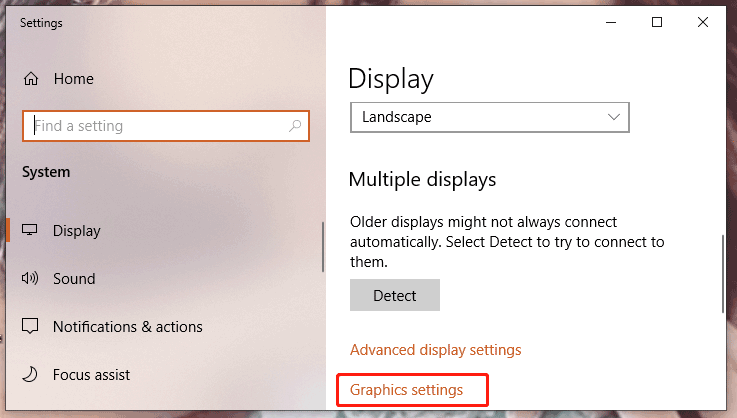
Step 4. Turn on Hardware-Accelerated GPU scheduling.
Warning: This tool is only available for GeForce 10, Radon 5600 or Radeon 5700 users to improve their system performance and reduce latency. If experiencing Hardware-Accelerated GPU Scheduling not showing, the only reason is that your hardware doesn’t support it at this moment.
Way 2: Enable Hardware-Accelerated GPU Scheduling via Registry Editor
Step 1. Press Win + R to open the Run dialog.
Step 2. Type regedit and hit Enter to launch Registry Editor.
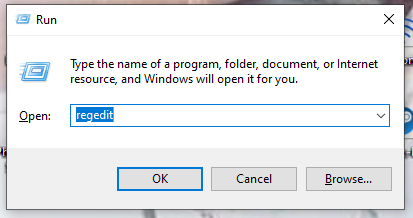
Step 3. Navigate to the following path:
HKEY_LOCAL_MACHINE\SYSTEM\CurrentControlSet\Control\GraphicsDrivers
Step 4. In the right pane, do a right-click on HwSchMode.
Step 5. In the drop-down menu, select Modify.
Step 6. Set the Value Data to 2 and click OK.
Step 7. Restart your PC to apply the changes.
Warning: It is noting although this feature allows you to play games on your PC with the best performance, it is very power-consuming when it is open for a long time. Therefore, you had better turn it off when stopping playing the game.
Final Words
By now, do you take a full picture of Hardware-Accelerated GPU Scheduling Windows 10/11? Do you have an idea about how to enable Hardware-Accelerated GPU Scheduling? Since we provide you with 2 ways to enable it, you can choose either of them. If you still have queries about it, please feel free to share them in the comment area below.
About The Author
Position: Columnist
Aurelie is a passionate soul who always enjoys researching & writing articles and solutions to help others. Her posts mainly cover topics related to games, data backup & recovery, file sync and so on. Apart from writing, her primary interests include reading novels and poems, travelling and listening to country music.
With Windows 10 update for May 2020 v2004, Microsoft introduced a new feature in the Settings app, known as “Hardware-Accelerated GPU Scheduling.” This feature has also been introduced to Windows 11.
When enabled, you can refine and enhance your gaming experience using the same hardware by increasing the GPU’s working capacity. By default, this feature is disabled.
Note that this option is only available if both your hardware and driver support it. Let’s see what benefits this feature brings to your gaming experience, and how you can enable it.
Table of Contents
What is Hardware-Accelerated GPU Scheduling and How it Works
Hardware-Accelerated GPU Scheduling allows you to optimize the speed of your dedicated GPU and enhance your overall gaming experience. Enabling it would drastically reduce latency, improve FPS, and generally improve your system’s performance.
Windows will automatically prioritize graphics-intensive tasks that require greater resources and execute such tasks on the dedicated GPU, which will be optimized after enabling Hardware-Accelerated GPU Scheduling.
However, Hardware-Accelerated GPU Scheduling allows the GPU to manage its own Virtual RAM (vRAM), rather than having it managed by the operating system.
Since the GPU will now manage its own vRAM, it eliminates the overhead time of communication with the OS, resulting in faster response rates from the GPU.
Read Microsoft’s blog post to learn more about the feature.
Prerequisites and Requirements
As we mentioned earlier, both the hardware and the drivers need to support the function to use it. Moreover, the operating system also needs to be Windows 10 v2004 (May 2020 update) or later.
Additionally, you must have a dedicated GPU on your PC. Your computer needs to have Nvidia GTX 1000 or later GPU, or AMD 5600 series or later GPU.
If you have the hardware, then you must also have the latest drivers for that hardware.
If you are using an NVIDIA dedicated GPU, then you must have a supported driver as well, which is 451.48, or later. Here is a guide on how to download the latest NVIDIA drivers.
If you are using an AMD GPU, you must have the Adrenalin 2020 Edition 20.5.1 Beta version of the driver or higher. As the name suggests, AMD is still working on the beta version for its support of hardware acceleration.
If you don’t have a high-grade GPU, you can still play graphics-intensive games using Cloud gaming services.
How to Enable Hardware-Accelerated GPU Scheduling in Windows
Once you have ensured that you have the supported hardware, its driver, and the supported OS version, you can now continue to enable the feature on your Windows device. Here are 2 ways to do so.
Enable Hardware-Accelerated GPU Scheduling using Settings App
Enabling the feature through the Settings application on a Windows PC is relatively easy, and literally just clicking a button. Follow the steps below:
-
Navigate to:
Settings app >> System >> Display
-
Click Graphics.
Open graphics settings -
Click “Change default graphics settings.”
Change default graphics settings -
Toggle the slider below “Hardware-accelerated GPU scheduling” into the On position.
Enable Hardware-Accelerated GPU Scheduling
You can now play games on your PC with optimal performance. However, note that this would consume more power.
If you wish to switch it off in the future, all you need to do is toggle the same slider again.
Enable Hardware-Accelerated GPU Scheduling using Registry Editor
Another way to switch on the feature in Windows is through the Windows Registry. Here is how:
Note: Misconfiguration of critical values in the system’s registry could be fatal for your operating system. Therefore, we insist that you create a system restore point before proceeding forward with the process.
You can also use our top selection of disk imaging and backup software so you never lose your data or operating system again.
-
Open the Registry Editor by typing in “regedit” in the Run Command box.
Open Registry Editor -
Paste the following location in the address bar for quick navigation:
Computer\HKEY_LOCAL_MACHINE\SYSTEM\CurrentControlSet\Control\GraphicsDrivers
Navigate to GraphicsDrivers key -
Double-click the “HwSchMode” value.
Edit HwSchMode value -
Change its value data to “2”.
Change Value Data to enable GPU hardware acceleration -
Restart the computer for the changes to take effect.
After the computer reboots, you will find that Hardware-Accelerated GPU Scheduling has been enabled.
In case you need to turn it off in the future, return to the same location within the Registry Editor and change the Value Data of “HwSchMode” to 1. This, too, will require a reboot.
Closing Words
Hardware acceleration is a neat trick to increase the performance of your PC. Since Microsoft has introduced it as a built-in feature in Windows 10, it does not require you to overclock your hardware. Thus, the GPU is not overburdened with the added load.
Unlike overclocking, your hardware is safe from over-utilization and unnecessary heat dissipation while using the Hardware-Accelerated GPU Scheduling feature.
What are the minimum requirements to enable Hardware-Accelerated GPU Scheduling?
Your computer must meet the minim requirements in terms of hardware, driver, and OS version to enable Hardware-Accelerated GPU Scheduling:
-Nvidia GTX 1000 or later GPU/AMD 5600 series or later GPU
-Nvidia driver version 451.48 later/ AMD Adrenalin edition 20.5.1 or later
-Windows 10 version 2004 or later
Is it safe to enable Hardware-Accelerated GPU Scheduling?
The short answer is Yes, it is safe to enable Hardware-Accelerated GPU Scheduling. This is because, unlike overclocking, GPU hardware acceleration does not put a significant load on the GPU. Instead, Hardware-Accelerated GPU Scheduling allows the GPU to manage its own vRAM, eliminating the overhead time of communication with the OS, resulting in faster response rates from the GPU.
В Windows 10, начиная с версии 2004 (обновление за май 2020 г.), появилась новая функция, известная как «Планирование графического процессора с аппаратным ускорением», которая является частью модели драйвера дисплея Windows (WDDM) 2.7 и позволяет поддерживаемым графическим картам управлять собственной памятью. уменьшить задержку и улучшить производительность.
Как следует из названия, новая функция Windows 10 позволяет как интегрированным, и выделенным графическим процессорам непосредственно управлять своей видеопамятью (VRAM), которая хранит текстуры, шейдеры и другую информацию.
Тем не менее функция, не работает прямо из коробки, поскольку требует новых драйверов от производителей видеокарт.
Nvidia
- Nvidia поддерживает Аппаратно-ускоренное планирование GPU, начиная с версии драйвера 451.48.
Intel
- Если у вас встроенная графика Intel, эта функция доступна начиная с версии драйвера 27.20.100.8190.
AMD
- В случае, если у вас есть карта AMD, компания выпустила бета-версию драйвера 20.5.1 с графикой аппаратного планирования. На данный момент драйвер предлагает поддержку новой функции Windows 10 для двух продуктов – серии Radeon 5700 и серии 5600. В случае, если у вас Ryzen, Vega, поддержка в настоящее время отсутствует, вам придется немного подождать.
В этом руководстве вы узнаете, как включить аппаратное планирование графики для Windows 10 версии 2004.
Как включить аппаратно-ускоренное планирование GPU в Windows 10.
Шаг 1: Откройте «Параметры» (Win I)
Шаг 2: Перейдите в раздел «Система» → «Дисплей».
Шаг 3: В разделе «Несколько дисплеев» нажмите ссылку «Настройки графики», чтобы изменить параметры графики по умолчанию.
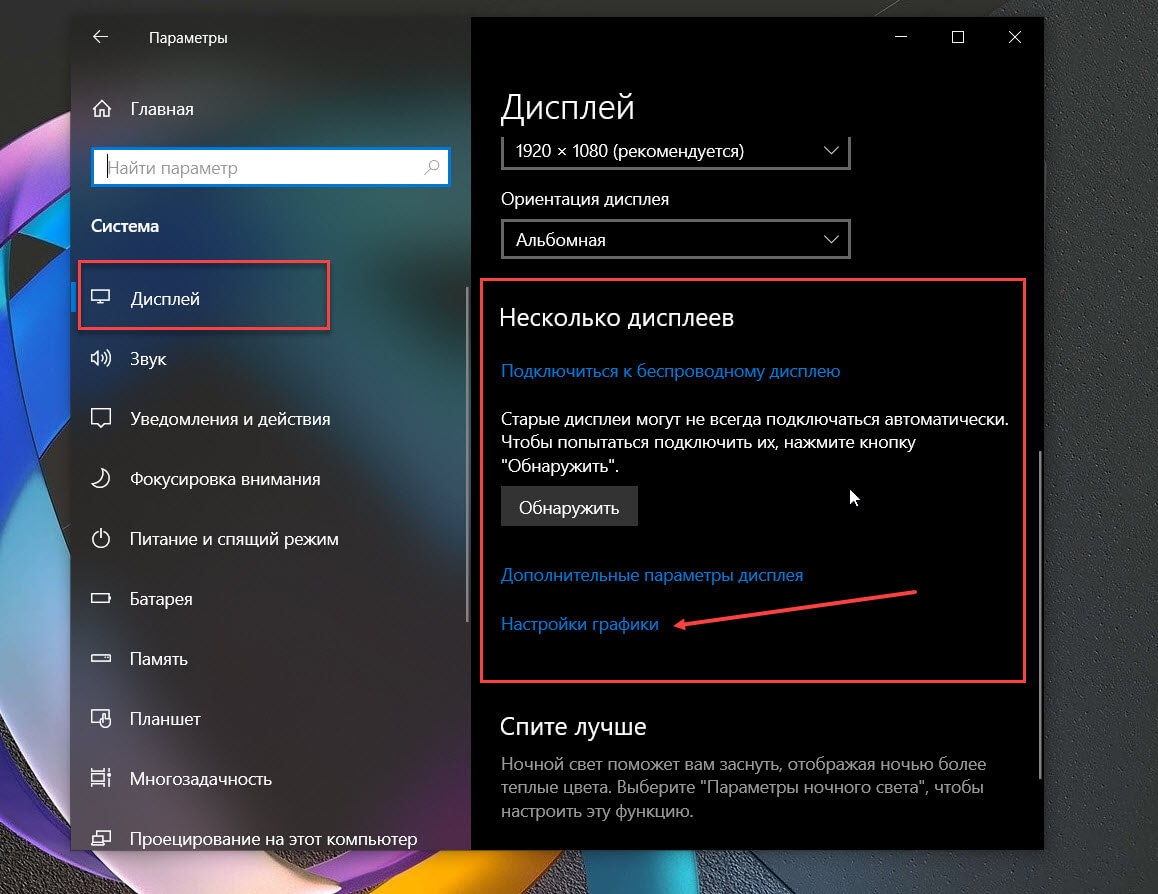
Шаг 4: Далее под строкой «Планирование графического процессора с аппаратным ускорением» передвиньте ползунок переключателя в положение «Вкл.», чтобы включить эту функцию в Windows 10.
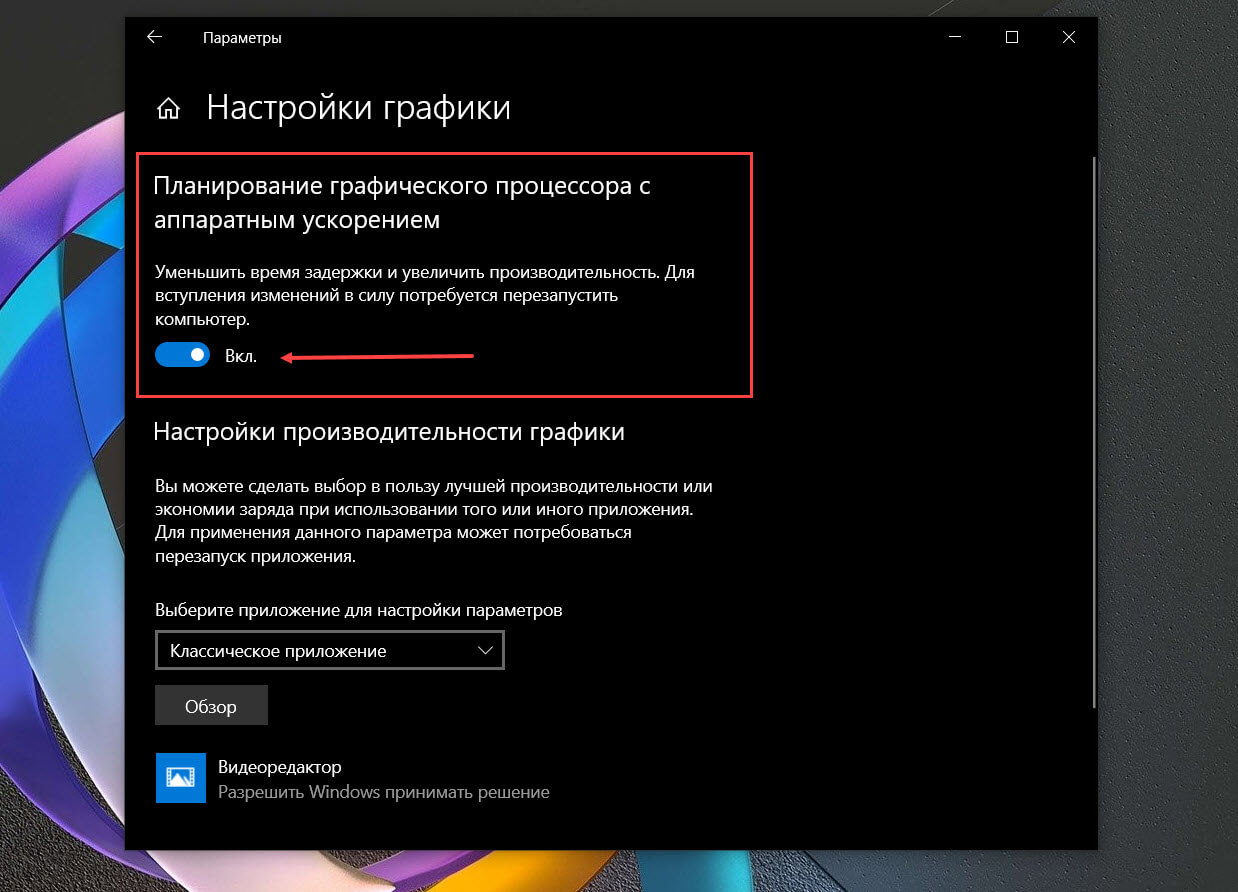
Шаг 5: Перезагрузите компьютер.
После того, как вы выполните эти шаги, новая опция начнет работать, играя в компьютерные игры вы увидите меньшее время задержки и увеличенную производительность.









